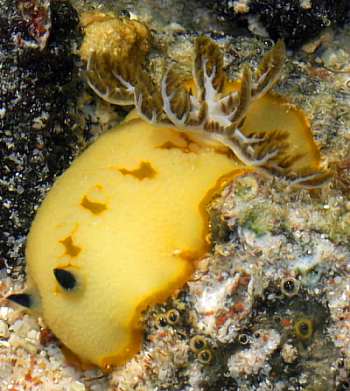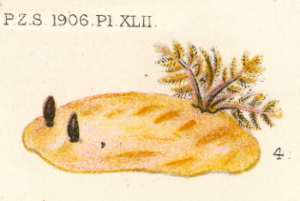

Taringa caudata
(Farran, 1905)
Order: NUDIBRANCHIA
Suborder: DORIDINA
Superfamily: EUDORIDOIDEA
Family: Discodorididae
DISTRIBUTION
Known only from the western Indian Ocean [records from Ceylon, Madagascar, Tanzania, Yemen.]
PHOTO
Upper: Socotra island, Yemen. Gulf of Aden. Depth: 1-2 metres. 05 January 2006. Intertidal. Photographer: Pashkov. Lower: Kelaart's original illustration of Doris luteola, first published by Eliot (1906, Pl 42, fig. 4).
First described as Doris luteola Kelaart, 1858 from the western Indian Ocean, it was recently re-examined and placed into the genus Taringa (see Gosliner & Behrens, 1998). However Schroedl (2003) has shown that the name Doris luteola Kelaart, 1858 is a primary homonym of the Chilean Doris luteola Couthouy in Gould, 1852, and so is not available for INdian Ocean species. However a species described from Ceylon (Thordisa caudata Farran, 1905) was considered by Eliot (1906) and Gosliner & Behrens (1998) to be the same species, so the first available name for this species is Taringa caudata (Farran, 1905).
The animal varies in background colour from a translucent creamy white to a pale yellow, with a yellowish brown mantle border. There are a series of brownish or yellow streaks and spots forming a pair of broken lines down the mantle from behind each rhinophore. The rhinophore club and stalk are black, and the gill stalks or branches are white, and the lamellae are brown.
There are raised rhinophore pockets, and the mantle is covered in small rounded tubercles. The gills are proportionally very large and elongate, consisting of long bipinnate branches and very sparse gill lamellae - similar to the shape of many species of Halgerda. Few specimens of this species have been reported. It grows to at least 25 mm in length.
There are raised rhinophore pockets, and the mantle is covered in small rounded tubercles. The gills are proportionally very large and elongate, consisting of long bipinnate branches and very sparse gill lamellae - similar to the shape of many species of Halgerda. Few specimens of this species have been reported. It grows to at least 25 mm in length.
-
Eliot, C.N.E. 1906. On the nudibranchs of southern India and Ceylon, with special reference to the drawings by Kelaart and the collections belonging to Alder and Hancock preserved in the Hancock Museum at Newcastle-on-Tyne. Proceedings of the Zoological Society of London, for 1906: 636-691.
-
Farran, G.P. 1905. Report on the opisthobranchiate Mollusca collected by Professor Herdman, at Ceylon, in 1902. Pp. 329-364 in: Report to the government of Ceylon on the pearl oyster fisheries of the Gulf of Manaar 3, Suppl. Rept. No. 21 (W.A. Herdman, ed.). Royal Society, London.
-
Gosliner, T.M. & Behrens, D.W. (1998) Two new discodorid nudibranchs from the western Pacific with a redescription of Doris luteola Kelaart, 1858. Proceedings of the California Academy of Sciences, 50(11), 279-293.
-
Schroedl, M., 2003 (Feb 3) Homonomy of Doris luteola Kelaart, 1858. [Message in] Sea Slug Forum. Australian Museum, Sydney. Available from http://www.seaslugforum.net/find/9092
Rudman, W.B., 2006 (January 24) Taringa caudata (Farran, 1905). [In] Sea Slug Forum. Australian Museum, Sydney. Available from http://www.seaslugforum.net/factsheet/taricaud
Related messages
-
Taringa caudata from Reunion Island
From: Hugues Flodrops, January 29, 2009 -
Taringa caudata from Oman
From: Michel Claereboudt, July 6, 2007 -
Re: Can you help Identify this Nudibranch?
From: Dave Behrens, January 25, 2006 -
Can you help Identify this Nudibranch?
From: Lev Sidorov, January 21, 2006 -
Homonomy of Doris luteola Kelaart, 1858
From: Michael Schroedl, February 3, 2003
